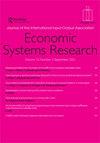Asymmetric tail risk contagion across China’s automotive industrial chain: a study based on input–output network
IF 1.8
4区 经济学
Q2 ECONOMICS
引用次数: 0
Abstract
AbstractThe input-output network of an industrial chain provides a channel for risk transmission. Using Smooth-Transition Vector Autoregression model (STVAR) and Diebold-Yilmaz directional connectedness measures, we explore tail risk (extreme risk) contagion across China’s automotive industrial chain. We find significant spillover effects that are asymmetric in different phases of China’s business cycle, monetary cycle, and policy uncertainty. When China’s economy is in a recession, under a monetary expansion, or at a high level of policy uncertainty, the total risk spillover across the chain is higher. We also find apparent risk spillover from the financial services industries to the automotive industrial chain as China’s economy is in a recession or a monetary expansion period. Still, a reverse spillover is found as policy uncertainty is at a high level. Meanwhile, the direction of risk propagation across the automotive industrial chain may change with the transition in the economic state or policy uncertainty state.KEYWORDS: Tail riskinput–output linkageasymmetric contagionChina’s automotive industrial chainJEL Classifications: C34E32E42F13L62 Disclosure statementNo potential conflict of interest was reported by the author(s).Notes1 The data for some variables in our research, such as the manufacturing PMI index, is only available from January 2005.2 The stock index of China’s insurance industry starts from January 2007, so we set its CoVaRs between January 2005 and November 2006 constant, equaling the CoVaR of January 2007.3 We collect data on China’s manufacturing PMI, CCI, MSR, and IOR from the WIND database of China.4 The Trade Policy Uncertainty Index (based on mainland newspapers) was made by Davis et al. (Citation2019). It can be found at www.policyuncertainty.com. The Exchange Rate and Capital Account Policy Uncertainty Index (based on the full sample of 114 mainland newspapers) constructed by Huang and Luk (Citation2019) is available at http://economicpolicyuncertaintyinchina.weebly.com.9 We use two composite indicators to check whether the probability of the economy being in recession matches the recession dates in China’s economy. One is the Macroeconomic Climate Index (MCI), published by China’s National Bureau of Statistics. The other one is the Composite Leading Indicator (CLI), designed by the OECD. Based on MCI, we find 77 months are in recession, occupying about 38.9% of the time in our sample period. Based on CLI, we find 76 months in our sample period are identified as recession dates, which occupy about 38.4% of the total 198 sample months. In our results, the number of months that the transition function F(zt) of PMI or CCI is smaller than 0.5 is 74, occupying about 37.4% of the total. According to MCI and CLI, the likelihood that the economy is in a recession roughly corresponds with the recession dates in China’s economy.10 In the NBER’s convention for measuring the duration of a recession, the first month of the recession is the month following the peak, and the last month is the month of the trough.5 Based on the Schwarz information criterion, we choose two lags. The estimated smoothness parameter γ and threshold parameter c, defined in Equation 8, are 7.7 and −0.4 for PMI and 6.3 and -0.6 for CCI, respectively.6 We check the robustness of the results with respect to the different ordering of endogenous variables. In our STVAR model, there are 9 endogenous variables, so there are 9! = 362880 possible orderings. For computational considerations, we divide all orderings into three subgroups according to the position of the state variable, i.e., the state variable is put at first, middle, and last, respectively. Then, ten different orderings are randomly chosen from each subgroup. Throughout, we find that ‘risk spillover from one industry to the other', ‘total risk spillover’ and ‘net risk spillover' are completely unchanged.7 Based on the Schwarz information criterion, we choose two lags. The estimated smoothness parameter γ and threshold parameter c, defined in Equation 8, are 5.4 and 0.7 MSR, and 6.6 and -0.4 for IOR, respectively.8 Based on the Schwarz information criterion, we choose two lags. The estimated smoothness parameter γ and threshold parameter c, defined in Equation 8, are 3.7 and 0.2 for TPU and 5.2 and 0.9 for ECPU, respectively.Additional informationFundingThis work was supported by National Natural Science Foundation of China: [Grant Number 72171100]; Humanities and Social Science Fund of Ministry of Education of China: [Grant Number 18YJA790037].中国汽车产业链尾部风险不对称传染:基于投入产出网络的研究
【摘要】产业链的投入产出网络为风险传递提供了渠道。本文采用平滑过渡向量自回归模型(STVAR)和Diebold-Yilmaz定向连通性测度,探讨了尾部风险(极端风险)在中国汽车产业链上的传染。我们发现,在中国经济周期、货币周期和政策不确定性的不同阶段,溢出效应是不对称的。当中国经济处于衰退、货币扩张或政策高度不确定性时,整个链条的总风险溢出更高。我们还发现,当中国经济处于衰退或货币扩张时期时,金融服务业的风险会明显溢出到汽车产业链。然而,由于政策不确定性较高,出现了反向溢出效应。同时,在经济状态或政策不确定状态下,汽车产业链的风险传播方向可能会随着转型而发生变化。关键词:尾部风险投入产出关联不对称传染中国汽车产业链分类:C34E32E42F13L62披露声明作者未报告潜在利益冲突。注1在我们的研究中,一些变量的数据,如制造业PMI指数,只有2005年1月的数据。5.2中国保险业股票指数从2007年1月开始,因此我们将其2005年1月至2006年11月的CoVaR设为常数,等于2007年1月的CoVaR。4贸易政策不确定性指数(基于大陆报纸)由Davis等人(Citation2019)编制。可以在www.policyuncertainty.com上找到。Huang和Luk (Citation2019)构建的汇率和资本项目政策不确定性指数(基于114家大陆报纸的完整样本)可在http://economicpolicyuncertaintyinchina.weebly.com.9上获得。我们使用两个复合指标来检验经济陷入衰退的概率是否与中国经济的衰退日期相匹配。一种是中国国家统计局发布的宏观经济景气指数(MCI)。另一个指标是由经合组织设计的综合领先指标(CLI)。基于MCI,我们发现有77个月处于衰退状态,占样本周期的38.9%。基于CLI,我们发现样本周期中的76个月被确定为衰退日期,占198个样本月总数的38.4%。在我们的研究结果中,PMI或CCI的过渡函数F(zt)小于0.5的月数为74个,约占总数的37.4%。根据MCI和CLI,经济陷入衰退的可能性大致与中国经济的衰退日期相对应在国家经济研究局衡量衰退持续时间的惯例中,衰退的第一个月是高峰之后的一个月,最后一个月是低谷的一个月基于Schwarz信息准则,我们选择了两个滞后点。估计的平滑参数γ和阈值参数c,定义在公式8中,PMI分别为7.7和- 0.4,CCI分别为6.3和-0.6我们检查关于不同顺序的内生变量的结果的稳健性。在我们的STVAR模型中,有9个内生变量,所以有9!= 362880种可能的顺序。出于计算上的考虑,我们根据状态变量的位置将所有排序分为三个子组,即状态变量分别放在第一、中间和最后。然后,从每个子组中随机选择10个不同的排序。在整个过程中,我们发现“从一个行业到另一个行业的风险溢出”、“总风险溢出”和“净风险溢出”完全没有变化基于Schwarz信息准则,我们选择了两个滞后点。公式8中定义的估计平滑参数γ和阈值参数c的MSR分别为5.4和0.7,IOR分别为6.6和-0.4基于Schwarz信息准则,我们选择了两个滞后点。估计的平滑参数γ和阈值参数c,定义在式8中,TPU分别为3.7和0.2,ECPU为5.2和0.9。本研究由国家自然科学基金资助:[批准号:72171100];教育部人文社科基金项目:[批准号:18YJA790037]。
本文章由计算机程序翻译,如有差异,请以英文原文为准。
求助全文
约1分钟内获得全文
求助全文
来源期刊

Economic Systems Research
ECONOMICS-
CiteScore
5.60
自引率
4.00%
发文量
17
期刊介绍:
Economic Systems Research is a double blind peer-reviewed scientific journal dedicated to the furtherance of theoretical and factual knowledge about economic systems, structures and processes, and their change through time and space, at the subnational, national and international level. The journal contains sensible, matter-of-fact tools and data for modelling, policy analysis, planning and decision making in large economic environments. It promotes understanding in economic thinking and between theoretical schools of East and West, North and South.
 求助内容:
求助内容: 应助结果提醒方式:
应助结果提醒方式:


